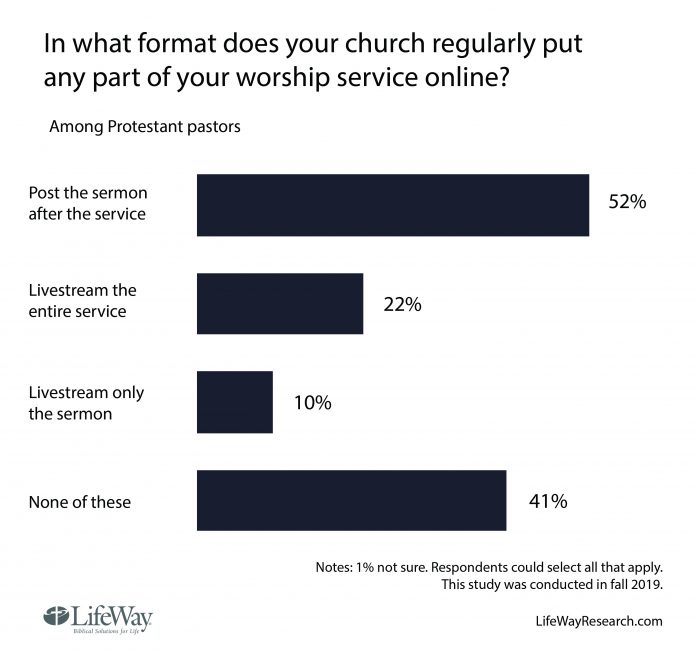NASHVILLE, Tenn. (BP) — The latest Centers for Disease Control and Prevention (CDC) guidance for groups during the COVID-19 coronavirus outbreak recommended no gatherings of more than 50 people for eight weeks. As churches scramble to make decisions on how to move forward, new research finds many congregations are not prepared to shift their services online.
A study from Nashville-based LifeWay Research conducted last fall found 41 percent of pastors say they don’t put any portion of their church service online for people to view.
Around half (52 percent) say they post the sermon online after the service is over, while 22 percent say they livestream the entire service and 10 percent say they livestream only the sermon.
“As new technologies have emerged, churches have placed their primary weekly worship service online in much the same way they did with radio and television,” said Scott McConnell, executive director of LifeWay Research.
“However, instead of only a few churches in each city broadcasting their service, online and streaming are economical enough for churches of all types to take advantage of the medium.”
In a related survey conducted last year, half of Protestant churchgoers (50 percent) say they watched a livestream in place of in-person church attendance at least once in the past year.
Of those who watched a livestream of their church service instead of attending in person, 2 in 5 (40 percent) say they did so once or twice. Around 1 in 3 (32 percent) say they did three to five times. Fewer did so six to 11 times (13 percent), 12 to 17 times (6 percent), or 18 times or more (9 percent).
Slightly less than half of all Protestant churchgoers (47 percent) say they haven’t watched a church service through a livestream as a replacement for in-person attendance in the past year. Two percent are not sure how many times, if any, they used livestreaming as a replacement.
Those who are part of smaller congregations are more likely to say they haven’t livestreamed a church service. Those who attend a church of fewer than 50 people (57 percent), 50 to 99 attendees (45 percent), and 100 to 249 attendees (53 percent) are more likely to say they didn’t stream any church services last year than those who attend a church of 500 or more (31 percent).
This may be explained in part by smaller churches being less likely to place any of their services online. Pastors of Protestant churches with fewer than 50 people (69 percent) and those with 50 to 99 (48 percent) are more likely than pastors of churches with 100 to 249 (28 percent) and those with 250 or more (10 percent) to say they don’t regularly put any of their worship service online.
“If they need to, almost a third of churches can gather virtually this week using technology and processes they already have in place,” said McConnell.
“Half of churchgoers have recent experience livestreaming a church service. And churches impacted first by CDC’s COVID-19 mitigation guidelines — those with attendance above 250 — are most prepared to provide their service online.”
Male churchgoers (55 percent) are more likely than female churchgoers (41 percent) to say they haven’t streamed a church service instead of attending in person in the past year.
Younger churchgoers, 18- to 34-year-olds (33 percent) and 35- to 49-year-olds (39 percent), are less likely to say they haven’t watched a livestream of a church service in the past year than older churchgoers, 55- to 64-year-olds (54 percent) and those 65 and older (62 percent).
Source: Baptist Press
All Content & Images are provided by the acknowledged source
